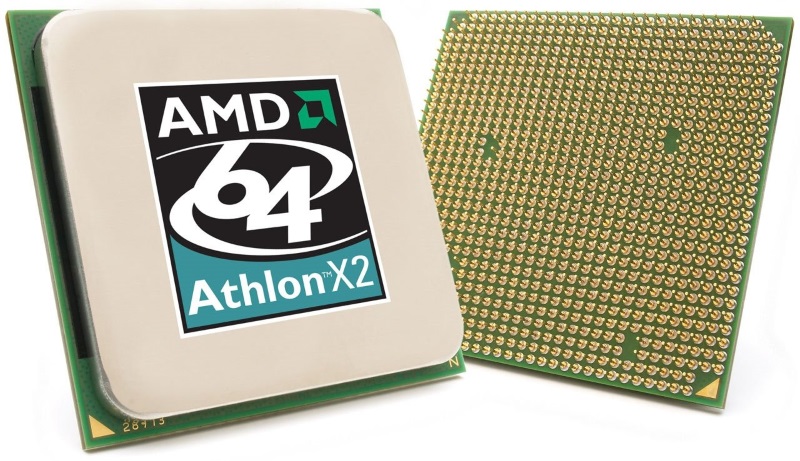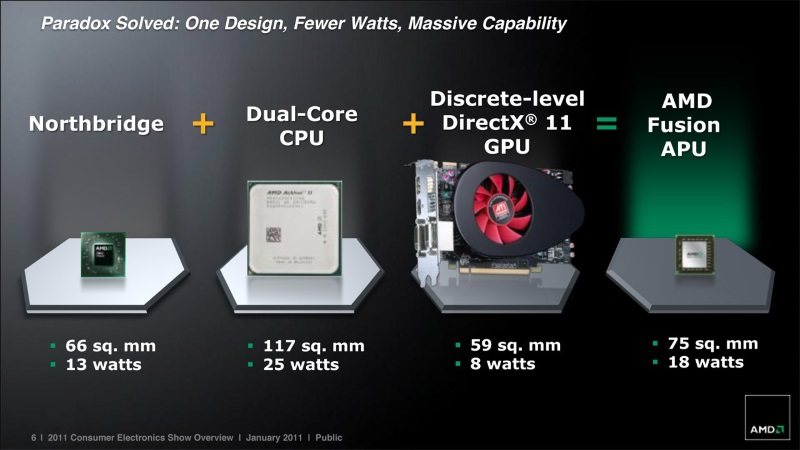Anthology of AMD processors: from Athlon 64 X2 to Ryzen

K8, K10 and K10.5
In 2006, Advanced Micro Devices released slightly updated K8 architecture processors called Windsor (90nm, 125W). The dual-core Athlon 64 X2 managed to overcome the "psychological threshold" of 3 GHz and catch up with the performance of the competing Pentium D. But by that time, Intel had already released completely new Core 2 Duo chips, which turned out to be more powerful and energy efficient (65 nm, 65 W). And there were already rumors about the quad-core Core 2 Quad. Therefore, AMD needed to urgently take a reciprocal step.
 |
In just a year, a new K10 architecture was developed (the name K9 was decided to be skipped due to its similarity with the English word "Canine", which translates as "Dog"). As a result, AMD even managed to get ahead of Intel with the release of the first true quad-core Phenom X4 Agena processor. Whereas Core 2 Quad was two dual-core chips on one substrate.
But the haste proved fatal. All early 65nm AMD chips, including the quad-core Phenom X4, the triple-core Phenom X3 (Toliman), the dual-core Athlon 64 X2 (Brisbane), and even the single-core Sempron (Sparta), were affected by the TLB error. Motherboard manufacturers hastily released a BIOS update that fixes the problem, but at the same time significantly slowed down performance. So, the new 65nm Athlon 64 X2 5200+ 2.7GHz turned out to be no faster than the old 90nm 3800+ 2GHz. The TLB problem was completely solved only with the transfer of processor production to a new stepping.
The second-generation 45-nm Phenom chips were called upon to restore the good reputation of the company. The second attempt was much more successful than the first. The hit of sales was not so much the quad-core Phenom II X4 Deneb, but the 3- and 2-core models (Heka and Callisto, respectively). The fact is that these were quad-cores with locked cores, which with a high probability could be activated. In the price lists of stores, there were even separate commodity items, for example, "Phenom II X2, unlocked, verified."
Bulldozer and Piledriver
In 2011, Intel moved to a power efficient 32nm process and introduced an extensive line of Core i3, i5 and i7 processors in the high performance Westmere architecture. AMD's answer in the face of the six-core Phenom II X6 Thuban looked unconvincing: the cores were already weak at that time, modern SSE 4.1 instructions were not supported, and they heated up like a stove.
A new 32-nm family of AMD chips called FX(Zambezi) has become a full-fledged competitor to Intel Westmere. Models of the FX-4000 sub-series received four Bulldozer cores, FX-6000 - six cores, and FX-8000 - eight. But it should be borne in mind that the Bulldozer cores are paired by two and have a common cache and a floating point unit. Simply put, the performance of one dual-core Bulldozer block is approximately equal to two virtual cores of Intel Hyper-Threading.
 |
The modified architecture that came out a year later was called Piledriver (Vishera). The FX line was replenished with the 9000 series - selected eight-core processors with a frequency of up to 5 GHz. However, all FX chips have an unlocked multiplier, which allows them to be manually overclocked to at least 4.6 GHz.
Initially, Bulldozer and Piledriver were not popular due to the high price. Commercial success came to them only three years later, when their prices dropped significantly and, most importantly, computer games came out, for which four streams were not enough. So, the eight-core FX-8300 cost the same as the four-core Core i3-6100.
APU Fusion
Back in 2006, AMD acquired one of the two largest video card manufacturers, ATI Technologies. Since that time, there has been talk of "hybrid" processors (APUs) with powerful integrated Radeon graphics. The project was called Fusion (now this term is no longer used), but was implemented only five years later.
 |
The first APU chips were Bobcat and Llano (new E and A lines). The younger Bobcats (aka Brazos or Zacate) were planned as an energy-efficient answer to Intel Atom processors, which ruled the roost in the then popular netbook and transformer market. But the Bobcat turned out to be much more energy-hungry than the Atom, and did not become widespread.
The older Llano on the K10.5 architecture turned out to be quite balanced and made it possible to comfortably play Dota 2 and Counter-Counter: Global Offensive on the integrated graphics. But bad luck - they had a separate FM1 socket, and not AM3 +, like the multi-core Bulldozer processors. This did not allow for the first time to buy Llano and sit out on integration, and then upgrade to FX and a discrete video card.
 |
And worst of all, just a year later, Llano was replaced by Trinity with a more modern Piledriver architecture and a new FM2 socket. Subsequently, Kaveri and Godavari chips came out, but the differences from Trinity were minimal.
As a result, the AMD FM2 platform remained interesting, but a dead end in terms of upgrade. The latest Stony Ridge and Bristol Ridge APUs on the Excavator architecture (slightly improved Bulldozer-Piledriver) differ only in support for the modern AM4 socket and DDR RAM. But Microsoft and Sony have appreciated AMD APUs and made them the basis of their Xbox One and Sony PlayStation 4 game consoles.
Ryzen and Threadripper
For five long years, dedicated AMD fans have been waiting for a truly new processor architecture and finally they have. In 2017, Ryzen chips with four to eight cores of the Zen architecture and support for SMT virtual threads (similar to Intel Hyper-Threading) went on sale.
The new products turned out to be one and a half times faster than the old AMD FX, but a third weaker than the competing Intel Kaby Lake and Coffee Lake. However, the time for multi-threaded software, including games, has finally come and high performance per core has ceased to play an important role. To confirm this, AMD has released 16-core 32- thread Threadripper chips for professional video editing and 3D modeling. The main thing is that the ratio of price and number of thread cores is better for AMD than for Intel.
The new year 2018 promises to be even more successful for AMD: the line of Ryzen 2000 Zen + processors with increased frequency and optionally integrated Vega graphics has been announced.
Twelve-year history of Intel in one article.
The competition between AMD and Intel, as in the good old days, has heated up to red.
Affordable AMD 9000-series processors with powerful integrated graphics.
16 cores in a home computer? Easy with AMD Threadripper processors!
Optimal AMD processors for office work, gaming and video editing.






















